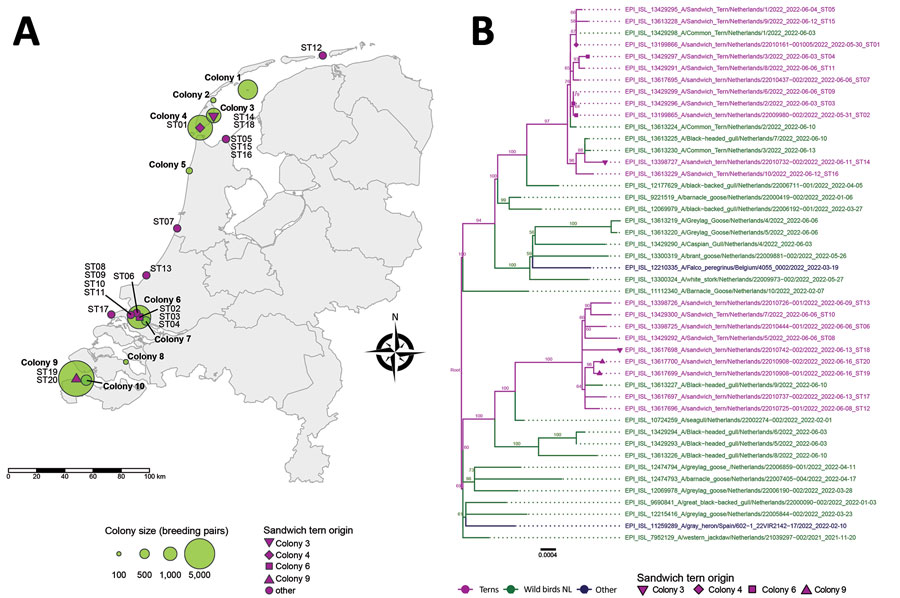Mass Mortality Caused by Highly Pathogenic Influenza A(H5N1) Virus in Sandwich Terns, the Netherlands, 2022
Jolianne M. Rijks
1
, Mardik F. Leopold
1, Susanne Kühn, Ronald in ‘t Veld, Fred Schenk, Allix Brenninkmeijer, Sander J. Lilipaly, Mónika Z. Ballmann, Leon Kelder, Job W. de Jong, Wouter Courtens, Roy Slaterus, Erik Kleyheeg, Sandra Vreman, Marja J.L. Kik, Andrea Gröne, Ron A.M. Fouchier, Marc Engelsma, Mart C.M. de Jong, Thijs Kuiken, and Nancy Beerens
Author affiliations: Dutch Wildlife Health Centre, Utrecht University, Utrecht, the Netherlands (J.M. Rijks, M.J.L. Kik, A. Gröne); Wageningen Marine Research, Den Helder, the Netherlands (M.F. Leopold, S. Kühn); Staatsbosbeheer Zuid-Hollandse Delta, Numansdorp, the Netherlands (R. in ’t Veld); Stichting Het Zeeuwse Landschap, Wilhelminadorp, the Netherlands (F. Schenk); Province of Groningen, Groningen, the Netherlands (A. Brenninkmeijer); Deltamilieu Projecten, Vlissingen, the Netherlands (S.J. Lilipaly, M.Z. Ballmann); Staatsbosbeheer Beheereenheid de Kop, Schoorl, the Netherlands (L. Kelder); Bureau Waardenburg, Culemborg, the Netherlands (J.W. de Jong); Research Institute for Nature and Forest, Brussels, Belgium (W. Courtens); Sovon Dutch Centre for Field Ornithology, Nijmegen, the Netherlands (E. Kleyheeg, R. Slaterus); Wageningen Bioveterinary Research, Lelystad, the Netherlands (S. Vreman, M. Engelsma,, N. Beerens); Department of Viroscience, Erasmus MC, Rotterdam, the Netherlands (R.A.M. Fouchier, T. Kuiken); Wageningen University and Research, Quantitative Veterinary Epidemiology group, Wageningen, the Netherlands (M.C.M. de Jong)
Main Article
Figure 1

Figure 1. Location of Sandwich terns affected by locally acquired highly pathogenic avian influenza A(H5N1) clade 2.3.4.4b viruses and phylogeny of viral segments, the Netherlands. A) Location and size (number of breeding pairs) of the Sandwich tern breeding colonies and the origin (finding location) of the Sandwich terns from which virus sequences ST01–ST20 shown in the phylogenetic tree in panel B were obtained. B) Maximum-likelihood tree (1,000 bootstraps) of the concatenated viral segments showing the H5N1 viruses detected in Sandwich terns together with viruses from other wild birds. Bootstrap values >50 are indicated at the branches. Identification numbers and symbols of the Sandwich terns correspond to those in the map, and the date that the bird was found dead is indicated. The GISAID sequences used in the phylogenetic analysis are listed in Appendix 1 Table 2. ST, Sandwich tern.
Main Article
Page created: October 21, 2022
Page updated: November 22, 2022
Page reviewed: November 22, 2022
The conclusions, findings, and opinions expressed by authors contributing to this journal do not necessarily reflect the official position of the U.S. Department of Health and Human Services, the Public Health Service, the Centers for Disease Control and Prevention, or the authors' affiliated institutions. Use of trade names is for identification only and does not imply endorsement by any of the groups named above.
